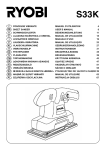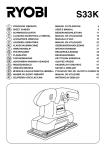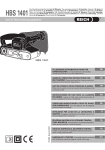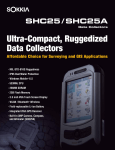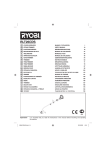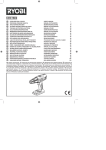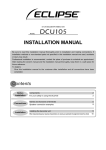Download Ryobi ESS-3215V User`s manual
Transcript
ESS-3215V(EU)-1.qxd 12/7/03 8:48 AM Page A1 ESS-3215V F PONCEUSE VIBRANTE GB SHEET SANDER MANUEL D’UTILISATION 1 USER’S MANUAL 7 D SCHWINGSCHLEIFER BEDIENUNGSANLEITUNG E LIJADORA ORBITAL MANUAL DE UTILIZACIÓN 18 I LEVIGATRICE ORBITALE MANUALE D’USO 24 P LIXADEIRA VIBRATÓRIA MANUAL DE UTILIZAÇÃO 30 NL VLAKSCHUURMACHINE GEBRUIKERSHANDLEIDING 36 S INSTRUKTIONSBOK 42 BRUGERVEJLEDNING 47 BRUKSANVISNING 52 VIBRATIONSSLIP DK RYSTEPUDSER N PLANSLIPER 12 FIN TÄRYHIOMAKONE KÄYTTÄJÄN KÄSIKIRJA 57 GR ΠΑΛΜΙΚΟ ΤΡΙΒΕΙΟ ΟΔΗΓΙΕΣ ΧΡΗΣΗΣ 62 H REZGŐCSISZOLÓ HASZNÁLATI ÚTMUTATÓ 68 CZ VIBRAČNÍ BRUSKA NÁVOD K OBSLUZE 74 RUS ÇàÅêéòãàîéÇÄãúçÄü åàòàçÄ êìäéÇéÑëíÇé èé ùäëèãìÄíÄñàà 79 RO MAŞINA DE ŞLEFUIT VIBRANTĂ MANUAL DE UTILIZARE 84 INSTRUKCJA OBSŁUGI 90 SLO BRUSILKA S PLOŠČO UPORABNIŠKI PRIROČNIK 96 HR VIRIRAJUΔA BRUSILICA KORISNI»KI PRIRU»NIK 101 TR TİTREŞİMLİ ZIMPARA ALETİ KULLANMA KILAVUZU 106 PL SZLIFIERKA OSCYLACYJNA ESS-3215V(EU)-1.qxd 12/7/03 8:48 AM Page A2 1 2 7 3 4 9 8 6 5 10 Fig.1 Fig.2 Fig.3 Fig.4 ESS-3215V(EU)-1.qxd 12/7/03 8:48 AM Page A3 11 12 11 9 13 Fig.5 Fig.6 ESS-3215V(EU)-1.qxd 12/7/03 8:49 AM Page A4 Attention ! Il est indispensable que vous lisiez les instructions contenues dans ce manuel avant le montage et la mise en service de l’appareil. Important! It is essential that you read the instructions in this manual before mounting and operating this machine. Achtung! Bitte lesen Sie unbedingt vor Montage und Inbetriebnahme die Hinweise dieser Bedienungsanleitung. ¡Atención! Es imprescindible que lea las instrucciones de este manual antes del montaje y de la puesta en servicio. Attenzione! Prima di procedere al montaggio e alla messa in funzione, è indispensabile leggere attentamente le istruzioni del presente manuale. Atenção! É indispensável ler as instruções deste manual antes de montar e pôr em serviço. Let op ! Het is absoluut noodzakelijk vóór montage en inbedrijfstelling de aanwijzingen in deze handleiding te lezen. Observera! Det är nödvändigt att läsa instruktionerna i denna bruksanvisning före montering och driftsättning. OBS! Denne brugsanvisning skal læses igennem inden montering og ibrugtagning. Advarsel! Vennligst les instruksjonene i denne bruksanvisningen før du monterer og tar i bruk maskinen. Huomio! On ehdottoman välttämätöntä lukea tässä käyttöohjeessa annetut ohjeet ennen asennusta ja käyttöönottoa. Προσοχή! Είναι απαραίτητο να διαβάσετε τις συστάσεις των οδηγιών αυτών πριν τη συναρμολγηση και τη θέση σε λειτουργία Figyelem! Feltétlenül fontos, hogy a jelen használati útmutatóban foglalt előírásokat az összeszerelés és az üzembe helyezés ellőt elolvassa! Důležité upozornění! Před montáží nářadí a uvedením do provozu je nutné si přečíst následující pokyny. ÇÌËχÌËe! èee‰ Ò·ÓÍÓÈ Ë Á‡ÔÛÒÍÓÏ ËÌÒÚÛÏeÌÚ‡ ÌeÓ·ıÓ‰ËÏÓ ÔÓ˜eÒÚ¸ ËÌÒÚÛ͈ËË ËÁ ̇ÒÚÓfl˘e„Ó ÛÍÓ‚Ó‰ÒÚ‚‡. Atenţie! Este indispensabil sã citiţi instrucţiunile conţinute în acest mod de utilizare înainte de montaj şi de punerea în funcţiune. Uwaga! Przed montowaniem i uruchomieniem, koniecznie musicie się Państwo zapoznać z zaleceniami zawartymi w niniejszym sposobie użycia. Pomembno! Zelo pomembno je, da pred namestitvijo in prvo uporabo te naprave preberete navodila v tem priročniku. Upozorenje! Vaæno je da upute u ovom KorisniËkom priruËniku proËitate prije postavljanja i uporabe ovog alata. Dikkat! Montajdan ve aletin kullanmna başlamadan bu klavuzda bulunan talimatlar okumanz gerekmektedir. Sous réserve de modifications techniques / Subject to technical modifications / Technische Änderungen vorbehalten / Bajo reserva de modificaciones técnicas / Con riserva di eventuali modifiche tecniche / Com reserva de modificações técnicas / Technische wijzigingen voorbehouden / Med förbehåll för tekniska ändringar / Med forbehold for tekniske ændringer / Med forbehold om tekniske endringer / Tekniset muutokset varataan / Υπ την επιφύλαξη τεχνικών τροποποιήσεων / A műszaki módosítás jogát fenntartjuk / Změny technických údajů vyhrazeny / åÓ„ÛÚ ·˚Ú¸ ‚ÌeÒeÌ˚ ÚeıÌ˘eÒÍËe ËÁÏeÌeÌËfl / Sub rezerva modificaţiilor tehnice / Z zastrzeżeniem modyfikacji technicznych / Tehnične spremembe dopuščene Podloæno tehniËkim promjenama / Teknik düzeltmeler hakk sakldr ESS-3215V(EU)-1.qxd F GB D E 12/7/03 I P 8:49 AM NL S Page 8 DK N FIN GR H CZ RUS RO PL SLO HR TR English IMPORTANT READ THESE SAFETY INSTRUCTIONS. ■ Before using the 1/2 SHEET SANDER, please read the manual carefully, especially the safety instructions. Keep this manual for future reference. ELECTRICAL SAFETY ■ GENERAL SAFETY RULES WARNING Read all instructions. Failure to follow all instructions listed below may result in electric shock, fire and/or serious injury. The term "power tool'' in all of the warnings listed below refers to your mains operated (corded) power tool or battery operated (cordless) power tool. ■ ■ SAFETY ALERT SYMBOL. Indicates caution or warning. May be used in conjunction with other symbols or pictures. ■ WARNING: Failure to obey a safety warning can result in serious injury to yourself or to others. Always follow the safety precautions to reduce the risk of fire, electric shock and personal injury. ■ WARNING: Do not attempt to operate this tool until you have read thoroughly and understood completely safety rules, etc. contained in this manual. Failure to comply can result in accidents involving fire, electric shock or serious personal injury. Save owners manual and review frequently for continuing safe operation and instructing others who may use this tool. ■ ■ ■ WORK AREA ■ Power tool plugs must match the outlet. Never modify the plug in any way. Do not use any adapter plugs with earthed (grounded) power tools. Unmodified plugs and matching outlets will reduce risk of electric shock. Avoid body contact with earthed or grounded surfaces such as pipes, radiators, ranges and refrigerators. There is an increased risk of electric shock if your body is earthed or grounded. Do not expose power tools to rain or wet conditions. Water entering a power tool will increase the risk of electric shock. Do not abuse the cord. Never use the cord for carrying, pulling or unplugging the power tool. Keep cord away from heat, oil, sharp edges or moving parts. Damaged or entangled cords increase the risk of electric shock. When operating a power tool outdoors, use an extension cord suitable for outdoor use. Use of a cord suitable for outdoor use reduces the risk of electric shock. If operating a power tool in a damp location is unavoidable, use a residual current device (RCD) protected supply. Use of an RCD reduces the risk of electric shock. PERSONAL SAFETY The operation of any tool can result in foreign objects being thrown into your eyes, which can result in severe eye damage. Before beginning power tool operation, always wear safety goggles or safety glasses with side shields and a full face shield when needed. We recommend Wide Vision Safety Mask for use over eyeglasses or standard safety glasses with side shields. ■ Keep children and bystanders away while operating a power tool. Distractions can cause you to lose control. Keep work area clean and well lit. Cluttered and dark areas invite accidents. Do not operate power tools in explosive atmospheres, such as in the presence of flammable liquids, gases, or dust. Power tools create sparks which may ignite the dust or fumes. ■ 8 Stay alert, watch what you are doing and use common sense when operating a power tool. Do not use a power tool while you are tired or under the influence of drugs, alcohol or medication. A moment of inattention while operating power tools may result in serious personal injury. Use personal protective equipment. Always wear eye protection. Protective equipment such as dust mask, non-skid safety shoes, hard hat, or hearing protection used for appropriate conditions will reduce personal injuries. Prevent unintentional starting. Ensure the switch is in the off-position before connecting to power source and/or battery pack, picking up or carrying the tool. Carrying power tools with your fi nger on the switch or plugging in power tools that have the switch on invites accidents. ESS-3215V(EU)-1.qxd F GB D E 12/7/03 I P 8:49 AM NL S Page 9 DK N FIN GR H CZ RUS RO PL SLO HR TR English in a hazardous situation. GENERAL SAFETY RULES ■ ■ ■ ■ SERVICE Remove any adjusting key or wrench before turning the power tool on. A wrench or a key left attached to a rotating part of the power tool may result in personal injury. Do not overreach. Keep proper footing and balance at all times. This enables better control of the power tool in unexpected situations. Dress properly. Do not wear loose clothing or jewellery. Keep your hair, clothing and gloves away from moving parts. Loose clothes, jewellery or long hair can be caught in moving parts. If devices are provided for the connection of dust extraction andcollection facilities, ensure these are connected and properly used. Use of these devices can reduce dust related hazards. ■ ■ POWER TOOL USE AND CARE ■ ■ ■ ■ ■ ■ ■ Have your power tool serviced by a qualified repair person using only identical replacement parts. This will ensure that the safety of the power tool is maintained. Check damaged parts. Before further use of the tool, a guard or other part that is damaged should be carefully checked to determine that it will operate properly and perform its intended function. Check for alignment of moving parts, free running of moving parts, breakage of parts, mounting and any other part that is damaged should be properly repaired or replaced by an authorized service center unless otherwise indicated in this instruction manual. Have defective switches replaced by an authorized service facility. Do not use the tool if the switch does not turn it on and off. SPECIFIC SAFETY INSTRUCTIONS FOR SANDERS Do not force the power tool. Use the correct power tool for your application. The correct power tool will do the job better and safer at the rate for which it was designed. Do not use the power tool if the switch does not turn it on and off. Any power tool that can not be controlled with the switch is dangerous andmust be repaired. Disconnect the plug from the power source before making any adjustments, changing accessories, or storing power tools. Such preventive safety measures reduce the risk of starting the power tool accidentally. Store idle power tools out of the reach of children and do not allow persons unfamiliar with the power tool or these instructions to operate the power tool. Power tools are dangerous in the hands of untrained users. Maintain power tools. Check for misalignment or bindling of moving parts, breakage of parts and any other condition that may affect the power tools operation. If damaged, have the power tool repaired before use. Many accidents are caused by poorly maintained power tools. Keep cutting tools sharp and clean. Properly maintained cutting tools with sharp cutting edges are less likely to bind and are easier to control. Use the power tool, accessories and tool bits etc., in accordance with these instructions and in the manner intended for the particular type of power tool, taking into account the working conditions and the work to be performed. Use of the power tool for operations different from intended could result ■ ■ ■ ■ Always wear safety goggles and a dust mask when sanding, especially sanding over-head. The machine is not suitable for wet sanding. Do not use sanding paper larger than needed. Extra paper extending beyond the sanding pad can also cause serious lacerations. The dust bag shall be equipped with the tool. And it shall be emptied frequently. To connect dust bag, insert the adapter of dust bag to the dust-collection opening on the rear end of the sander. WARNING Do not throw sanding dust on an open fire because materials in fine particle form may be explosive. WARNING A suitable breathing respirator must be worn while sanding lead paint, some woods and metal to avoid breathing the harmful/toxic dust or air. SYMBOL The following show the symbols used for the tool. Be sure that you understand their meaning before use. V.................................................................................Volts Hz..............................................................................Hertz ~...........................................................Alternating Current 9 ESS-3215V(EU)-1.qxd F GB D E 12/7/03 I P 8:49 AM NL S Page 10 DK N FIN GR H CZ RUS RO PL SLO HR TR English W...............................................................................Watts 9. 10. 11. 12. 13. SYMBOL no................................................................No load Speed min-1.....................Revolutions or reciprocation per minute FEATURES Your sander is suitable for sanding with coarse, medium, and fine grit sandpaper. It will produce a fine scratch free finish when used to sand with the grain on wood surfaces. It has been designed so that flush corner sanding on three sides of the sander is possible. ..................................................................Pad Size .....................................................Double Insulation Your sander has a comfortable palm grip handle that provides maximum one-hand comfort, and reduces operator fatigue during continuous sanding operations. .......................................Read instruction manual .......................Wear Personal protective equipment Your sander also has a built in dust collection that collects dust through punched holes in the sandpaper and cushion (Fig. 5). .................................Recycle raw materials instead of disposing as waste. The machine, accessories and packaging should be sorted for environmental-friendly recycling. Before attempting to use your sander, familiarize yourself with all operating features and safety requirements. SPECIFICATION Input Wattage No load speed Orbital diameter Weight SWITCH (2) ESS-3215V 230 V ~ 50 Hz 320 W 6000-12000 min-1 2.2 mm 2.2 kg This tool is equipped with a simple switch control. To turn the sander "ON", slide the switch to the left. Slide the switch to the right to turn the sander "OFF". ELECTRONIC SPEED CONTROL(1) The electronic speed control allows the operator to adjust speed to meet varity sanding material from tough heavy grained timber to delicate veneer. APPLICATIONS WARNING Do not allow familiarity with your sander to make you careless. Remember, a careless fraction of a second is sufficient to inflict severe injury. Use only for the purposes listed below: ■ ■ ■ Non-Adhesive Sandpaper Dust Bag Assembly Handle of Clamp Clamp Adhesive Sandpaper Sanding on wood surfaces. Removing rust from and sanding steel surfaces. Sanding plastics. OPERATION DESCRIPTION 1. 2. 3. 4. 5. 6. 7. 8. WARNING Your sander should never be connected to power supply when you are assembling parts, making adjustments, assembling or replacing sandpaper, cleaning, or when not in use. Disconnecting sander will prevent accidental starting that could cause serious personal injury. Variation Speed Control “ON / OFF” Switch Trigger Power Supplier Cord Dust Exhaust Sanding Pad Assembly Platen Live Indicator Sandpaper Puncher INSTALLING SANDPAPER (Fig. 5) 10 ESS-3215V(EU)-1.qxd F GB D E 12/7/03 I P 8:49 AM NL S Page 11 DK N FIN GR H CZ RUS RO PL SLO HR TR English Inspect sandpaper before installing. DO NOT use if broken of defective. ■ Push down on sander SANDPAPER SELECTION INSTALLING ADHESIVE (HOOK& LOOP) Selecting the correct size grit and type sandpaper is an extremely important step in achieving a high quality sanded finish. Aluminum oxide, silicon carbide, and other synthetic abrasives are best for power sanding. Natural abrasives, such as flint and garnet are too soft for economical use in power sanding. SANDPAPER (13) OPERATION Unplug the sander. If replacing ahesive sandpaper, remove old sandpaper by peeling it off cushion. NOTE: Sand for a few minutes to soften the adhesive backing before attempting to remove old sandpaper. ■ Carefully peel adhesive backing from new 1/2 sheet sandpaper. ■ Position sandpaper, making sure front edge of sandpaper is aligned with front edge of the cushion, then carefully press sticky side of sandpaper on cushion. ■ If the new sandpaper have a dust hole, then align holes in paper with holes in cushion, then carefully press fuzzy side of sandpaper against cushion as tightly as possible. ■ In general, coarse grit will remove the most material and finer grit will produce the best finish in all sanding operations. The condition of the surface to be sanded will determine which grit will do the job. If the surface is rough, start with a coarse grit and sand until the surface is uniform. Medium grit may then be used to remove scratches left by the coarser grit and finer grit used for finishing of the surface. Always continue sanding with each grit until surface is uniform. ■ Note: DO NOT use sander without sandpaper. Doing so will damage the cushion. PREPARING FOR OPERATION CAUTION Be careful not to let your hand completely cover air vents. INSTALLING NON-ADHESIVE SANDPAPER (9) SANDING (Fig. 1) Lifting up the handle (11), and observing the sandpaper clamp (12) be lifting up also. ■ Insert end of new 1/2 sheet sandpaper approximately 1/2 in. (12.7mm) under the paper clamp. Note: 1/2 in. clamping of sandpaper is necessary for multisheet stacking of paper. ■ Release down the handle and apply clamp downward pressure to conform sandpaper to platen. ■ Wrap sandpaper around cushion. Lifting up another handle on opposite end of sander and insert loose end of sandpaper under clamp also. Fit sandpaper tight against with cushion. ■ Release down the handle. ■ Multi-sheet of sandpaper can be installed at one time for convenience. ■ WARNING Unsecured work could be thrown towards the operator causing injury. Hold your sander in front and away from you, keeping it clear of the workpiece. Start your sander by pressing the switch button to "ON" position and letting the motor build to its maximum speed. Gradually lower your sander on the work with a slight forward movement. Move it slowly using forward and backward strokes. DO NOT FORCE. The weight of the unit supplies adequate pressure, so let the sandpaper and sander do the work. Applying additional pressure only slows the motor, rapidly wears sandpaper and greatly reduces sander speed. Excessive pressure will overload the motor causing possible damage from motor overheating and can result in inferior work. PAPER PUNCH (Fig. 6) Any finish or resin on wood may soften from the frictional heat. Do not allow sanding on one spot too long as the sander's rapid action may remove too much material, making the surface uneven. A paper punch template has been supplied with your sander for aligning and punching holes in sandpaper. The punched holes must align with the holes in the sander cushion. ■ ■ WARNING Do not wear loose clothing or jewelry when operating sander. They could get caught in Install sandpaper on your sander. Align sander cushion over the paper punch. 11 ESS-3215V(EU)-1.qxd F GB D E 12/7/03 I P 8:49 AM NL S Page 12 DK N FIN GR H CZ RUS RO PL SLO HR TR English moving parts causing serious injury. Keep head away from sander and sanding area. Hair could be drawn into sander causing serious injury. WARNING Failure to unplug your sander could result in accidental starting causing possible serious personal injury. ORBITAL MOTION (Fig. 2) ■ Orbital motion is ideal for fast cutting action when removing old finishes, smoothing rough wood, cutting stock down to ■ ■ OPERATION ■ ■ required dimensions, or for finishing surfaces to be painted. The sandpaper moves in tiny circles at a very high speed, allowing the sander to move easily. LIVE TOOL INDICATOR This tool features a live tool indicator (7) which illuminates as soon as the tool is connected to the supply. This warns the user that the tool is connected and will operate when the switch is pressed. WARNING Collected sanding dust from sanding surface coatings such as polyurethanes, linseed oil, etc. can self-ignite in your sander dust bag or elsewhere and cause fire. To reduce the risk of fire always empty your dust bag frequently while sanding and never store or leave a sander without totally emptying its dust bag. Also follow the recommendations of the coatings manufacturers. MAINTENANCE WARNING The tool should never be connected to a power supply when you are assembling parts, making adjustments, cleaning, performing maintenance, or when the tool is not in use. Disconnecting the tool will prevent accidental starting that could cause serious injury. USING THE DUST BAG ASSEMBLY The dust bag assembly provides a dust collection system for the sander. Sanding dust is drawn up through the holes of the sanding disc and collected in the dust bag during sanding. WARNING When servicing use only identical Ryobi replacement parts. Use of any other parts may create a hazard or cause product damage. TO ATTACH THE DUST BAG ASSEMBLY (Fig. 3) Follow these directions to attach the dust bag assembly. ■ GENERAL Unplug the sander. Avoid using solvents when cleaning plastic parts. Most plastics are susceptible to various types of commercial solvents and may be damaged by their use. Use clean cloths to remove dirt, carbon dust, etc. WARNING Failure to unplug the tool could result in accidental starting causing possible serious injury. ■ WARNING Do not at any time let brake fluids, gasoline, petroleumbased products, penetrating oils, etc., come in contact with plastic parts. They contain chemicals that can damage, weaken, or destroy plastic. Slide the dust bag assembly onto the blower exhaust on the sander using a slight twisting motion. TO EMPTY THE DUST BAG ASSEMBLY (Fig. 4) For more efficient operation, empty the dust bag when it is no more than half full. This will permit the air to flow through the bag better. Always empty and clean the dust bag thoroughly upon completion of a sanding operation and before placing the sander in storage. Electric tools used on fiberglass material, wallboard, spackling compounds, or plaster are subject to accelerated wear and possible premature failure because the fiberglass chips and grindings are highly abrasive to bearings, brushes, commutators, etc. Consequently, we do not recommended using this tool for extended work on these types of materials. However, if you do To empty dust bag: ■ Remove the dust bag assembly from the sander. Remove the dust bag from the frame. Shake out the dust. Replace the dust bag on the frame. Replace the dust bag assembly on the sander. Unplug your sander. 12 ESS-3215V(EU)-1.qxd F GB D E 12/7/03 I P 8:49 AM NL S Page 13 DK N FIN GR H CZ RUS RO PL SLO HR TR English work with any of these materials, it is extremely important to clean the tool using compressed air. foreign material that can accumulate over time. To clean sanding sheets, rub the sheets with a hard rubber block. You can also use the clean rubber sole of a shoe. WARNING Always wear safety goggles or safety glasses with side shields during power tool operation or when blowing dust. If operation is dusty, also wear a dust mask. WARNING Always remove scrubbing or sanding pad from sander before cleaning. Failure to do so could cause serious personal injury. MAINTENANCE LUBRICATION All of the bearings in this tool are lubricated with a sufficient amount of high grade lubricant for the life of the unit under normal operating conditions. Therefore, no further lubrication is required. CLEANING THE SCRUBBING PADS To ensure longer life and optimum performance, periodically clean all sanding residue and foreign materials from the scrubbing pads. This can be done simply by rinsing the pad with warm water untill all foreign material has been washed away. After cleaning, gently squeeze the pad to remove excess water and allow pad to dry. Always store pads and sanding sheets flat in a cool dry location. CLEANING THE SANDING SHEETS The sanding sheets that came with your sander are made to be re-used. Therefore, it is important that they be cleaned periodically to remove sanding residue and 13










